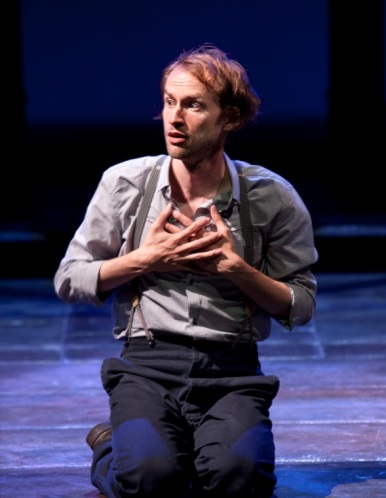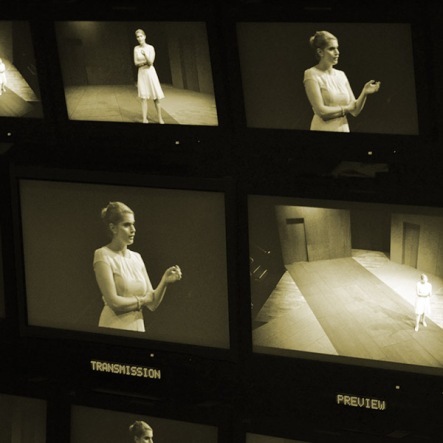It is with enormous pleasure that I welcome the first ever guest blog post on DigitalShakespeares. Over the past summer, Mary Odbert, one of our wonderfully talented MA students at the Shakespeare Institute, has been acting as a research assistant on this project, and she very graciously agreed to write up some of her final thoughts on the work she’s been doing. As you’ll see, much of this has involved watching and studying a selection of Shakespeare broadcasts, so, without any further ado, here’s Mary!
***
The Eye of the Camera in Filmed Theatre
Shakespeare’s presence in the digital world has opened up innumerable new modes of thought in both creative practice and criticism. In the process, a fledgling art form has emerged somewhere between the stage and the cinema in the form of the live theatre broadcast. It has been my pleasure this summer to work with Dr. Sullivan on her exploration of this new medium. To me, the most fascinating aspect of the live theatre broadcast is the means by which the camera affects the broadcast spectator’s experience of the theatrical production.
The camera’s control over our perspective may be written off as an understood necessity in the context of film. Its angles, distances, and movements are accepted as part of the calculated art of filmmaking and the spectator experiences the film through the lens for better or worse. However, in the case of a theatrical broadcast film, this trust in the camera is somewhat ruptured by the film viewer’s awareness of the in-theatre audience. While, on the one hand, in-theatre audiences are restricted to a single perspective by their physical stasis, they are nonetheless in control of their more specific focus. Although unable to cut to close-ups on facial expressions or wide birds-eye-view shots for dramatic effect, the in-theatre audience controls where they look and when. The spectator’s bodily autonomy may be obviously self-evident to anyone who has ever turned their head to look at something, but it’s a luxury which registers as taken for granted when the camera operator makes a choice you wouldn’t have done.
The Globe On Screen and The RSC Live use a fascinating array of camera techniques from self-contained framing to a complete avowal of the theatrical space, all to varying effect, but all nonetheless representative of specific stylistic choices. As a space wherein the theatre itself is as much a part of the experience as the production on its stage, The Globe On Screen tends more toward wide shots which include the building and the in-theatre audience. This choice is also partly driven by necessity simply due to the practical layout of the building. Apart from a straight shot from the front and center of the yard, there is essentially no angle which doesn’t inevitably include audience members in the background.
As a result, the films maintain a diegetic distance from the plays themselves, always reminding the viewer of the constructed nature of the drama. This result is by no means a reflection on any inability of the actors to engage the spectator into their world. In fact, this is often successfully the case for the standing spectators in the yard sharing the space of the characters. But by including the in-theatre spectators’ experience in the film, Globe On Screen adds a layer of non-diegetic reality between the diegetic scene on stage and the engagement of cinema spectators. Rather than watching the play itself, Globe On Screen viewers watch The Globe put on a play. In its own almost voyeuristic mode, The Globe On Screen film puts its viewers in a position of watching an audience watch a play.
The RSC generally takes a more cinematically-minded approach in their broadcasts. With more lighting technology and elaborate sets, the Royal Shakespeare Theatre has more tools with which to explore their own style of mise-en-scene in the filming process. Their films feature camera work which does more to exclude the audience from the frame, therefore keeping the diegetic engagement less disrupted for the broadcast spectators. High angled shots swooping down into powerful close ups enhance the impact of emotional moments. While the camera still enacts a certain authority over the film viewer’s point of view, moments like this exemplify the ways in which the camera provides perspectives otherwise impossible to the in-theatre audience.
In some ways, the divide in new opportunities for experimental effects between The Globe and its indoor counterpart is one which echoes back to the days of the Blackfriars Theatre in the early modern period. To a certain degree, it almost feels as though The Globe’s focus on original practices perhaps hinders its development in the filmic realm. Then again, to read The Globe’s approach more as a documentary of the theatrical experience rather than embracing the temptation to see it as a film adaptation of the play recasts the work as a success within its own multi-generic classification. Meanwhile, The RSC continues to experiment and discover as much with their live broadcast techniques as they do with their stage adaptations.
After analyzing this series of films, most from The Globe and The RSC along with several from The National Theatre for good measure, it seems clear that the entire notion of the digital broadcast of the stage production still has a great deal of development to come. This is not to suggest the films thus far haven’t been excellent, because they absolutely are! But it seems that the theatres are now reaching major turning point wherein the film is evolving beyond its point-and-shoot origins to embrace the artistry available to the cinematic mode. Rather than capturing the action on stage at its bare minimum with a static camera at the back of the audience, the filmed stage production is roaring to life as its own unique art form. The best parts of the shared theatrical experience, teleporting spectators from around the world into London’s Wooden O or the pride of Stratford’s riverside, blended together with the best of the cinema’s compositional techniques to create an unmatchable Shakespearean experience.
Guest post by Mary Odbert, MA Shakespeare Studies (Shakespeare Institute).













